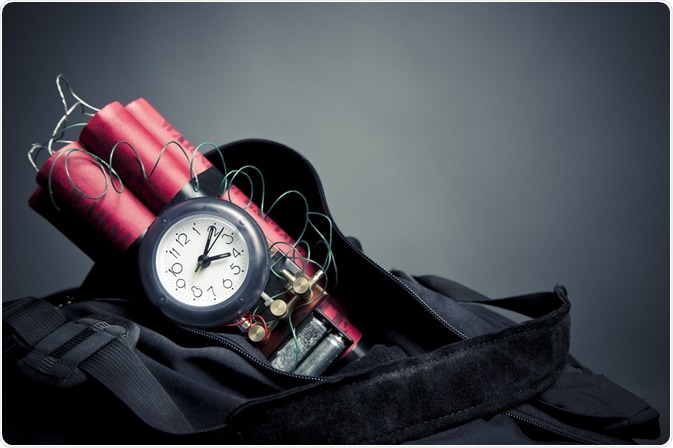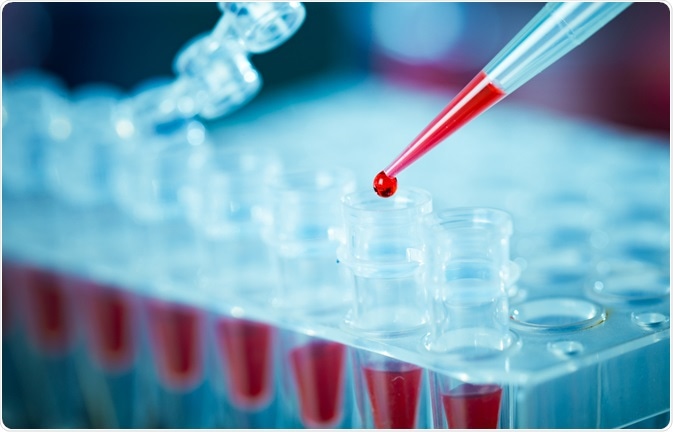Improvised explosive devices (IEDs) are frequently used in terrorist attacks worldwide, resulting in more than 11.000 total injuries to civilians annually. Therefore, it is crucial to develop and optimize a DNA recovery protocol that can yield results even when a minute amount of touch DNA is present on the surfaces of IEDs. Up until recently, the recovery rates of DNA evidence from IEDs have been relatively low.

Image Credit: Fer Gregory/Shutterstock.com
Main Challenges
The IEDs that found on crime scenes can consist of a wide array of metallic surfaces. This can be a hindering factor when it comes to a polymerase chain reaction (PCR) which is the main method used to amplify the very small quantities of DNA that are sometimes present on the IEDs.
DNA is a well-known metal chelator, or in other words, it can form several bonds with a single metal ion, and this exact property of DNA can create some implications when the DNA of interest is deposited on a metallic surface.
Specifically, metal cations may react with the phosphate backbone or the high electron density sites (Nitrogen and Oxygen). This can damage the DNA or act as a DNA polymerase inhibitor leading to a lack of Mg2+, which is a key component for a successful PCR.
Additionally, transition metals (and their respective alloys) which are very commonly found in many forensically relevant surfaces can display an even more complex interaction with DNA. The aforementioned metals possess the ability to form multiple cations with different ionic charges and that can lead to multiple site binding with DNA, which can even alter the double helix and cause oxidative damage via H202 oxidative radicals.
Moreover, although several studies have attempted to elucidate metal-DNA interactions, extrapolating their results to forensically relevant DNA might be a step too far. Most studies were conducted by using a DNA simulant and the amplification of DNA was solely focused on ionic bonding in a controlled in vitro setup.
Last but not least, the intense heat and pressure during an explosion has a detrimental effect on the DNA which denatures when the temperature reaches approximately 80°C, rendering any further recovery impossible.
DNA recovery methods from IEDs and improved protocols
A very common method in forensic science, ‘’swabbing’’ is extensively used for DNA sample collection. Swabs are utilized when collecting biological fluids and are generally considered a very cost-effective method, easy to use, and suitable for high throughput analysis.
Buffer solutions come hand in hand with ‘’swabbing’’ methods due to their property of binding metal ions that could potentially damage the phosphodiester bonds of DNA.
Another well-established procedure is tape lifting. The sticky side is repeatedly pressed against the surface of interest and eventually lifted for the subsequent extraction of DNA. A common practice to increase the efficacy of this technique is to irradiate extraneous DNA with UV light on the sticky side of the tape before using it.
Direct PCR is another processing technique that can be used for the recovery of DNA from IEDs. The difference of direct PCR compared to normal PCR is that the sample (usually a swab or a minute piece of the substrate) is directly amplified without the need for any extraction, quantification nor purification. Due to the advancements in polymerase buffer technology, direct PCR does not suffer from the influence of inhibitors (e.g. transition metals, salts, phenols).
In a recent study, Tonkrongjun et al. attempted to improve the current protocol for DNA recovery from IEDs. In their study, Fluorescent dyes (and a light source) were employed along with direct PCR. The study focused on PVC pipes and electrical tapes.
With their approach, locating the DNA rich areas is not difficult and it was proven that the stained DNA samples were successfully amplified with direct PCR, obtaining high partial profiles from an IED that had been handled for up to thirty seconds.
An interesting finding was that a certain dye that was used in this study, was suspected to be the potential culprit in some cases where low partial DNA profiles were obtained.
Currently, the body of research regarding DNA recovery from IEDs appears to be on the right path; however, there are still some knowledge gaps that need to be filled to obtain optimal results.
Metal-DNA interactions and its effects on DNA need to be studied further, especially those of alloys since these types of surfaces can be found in many of the IEDs recovered from crime scenes. An advanced understanding of the aforementioned interactions will result in better sample collection, clean-up, and will improve the quality of the recovered DNA.
Another point of emphasis would be conducting more studies that are including methods that performed well under controlled conditions and test the same methods in uncontrolled conditions that would mimic the standard police casework when it comes to IEDs found on crime scenes. This is the only objective way to assess the effectiveness of a new method/protocol.

Image Credit: luchschenF/Shutterstock.com
References
- Dan Osei Mensah Bonsu, Denice Higgins, Jeremy J. Austin (2020), Forensic touch DNA recovery from metal surfaces – A review, Science & Justice, 60(3), pp 206-215
- P. Tonkrongjun, P. Thanakiatkrai, S. Phetpeng, W. Asawutmangkul, S. Sotthibandhu, T. Kitpipit, (2017), Touch DNA localization and direct PCR: An improved workflow for STR typing from improvised explosive devices, Forensic Science International: Genetics Supplement Series, 6, pp e610-e612
- Sukanya Phetpeng, Thitika Kitpipit, Vatee Asavutmangkul, Weawgarn Duangshatome, Wannarat Pongsuwan, Phuvadol Thanakiatkrai, (2013) Touch DNA collection from improvised explosive devices: A comprehensive study of swabs and moistening agents, Forensic Science International: Genetics Supplement Series, Volume 4(1), pp e29-e30
Last Updated: Jul 29, 2020